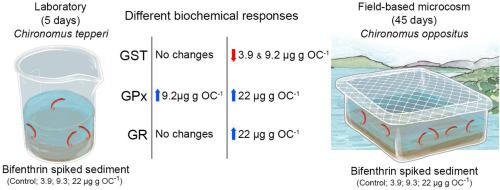Aquatic Toxicology ( IF 4.5 ) Pub Date : 2020-09-06 , DOI: 10.1016/j.aquatox.2020.105618 Maria L Ballesteros 1 , Rhianna L Boyle 2 , Claudette R Kellar 3 , Karina S B Miglioranza 4 , Maria A Bistoni 5 , Vincent Pettigrove 3 , Sara M Long 3

|
Bifenthrin is a second generation synthetic pyrethroid insecticide that is widely used in Australia and worldwide. It is frequently found in urban freshwater sediments at concentrations likely to impact biota as it is highly toxic to fish and macroinvertebrates, such as chironomids. Our main goal was to evaluate if oxidative stress and hydrolase enzymes are useful biomarkers of effect of synthetic pyrethroids exposure under different scenarios. Chironomus tepperi larvae (5 days old) were exposed to sub-lethal sediment concentrations of bifenthrin for 5 days under controlled laboratory conditions. A field-based microcosm exposure with bifenthrin-spiked sediments (using the same concentrations as the laboratory exposure) was carried out at a clean field site for four weeks to allow for colonization and development of resident chironomid larvae. At the end of both experiments, Chironomus larvae (C. tepperi in the laboratory exposures and C. oppositus in the microcosm exposures) were collected and oxidative stress enzymes (Glutathione-s-Transferase, Glutathione Reductase and Glutathione Peroxidase) and hydrolase enzymes (Acetylcholinesterase and Carboxylesterase) were measured.
Only the Glutathione Peroxidase activity was significantly impacted in larvae from the laboratory exposure. On the contrary, significant changes were observed in all the measured enzymes from the field-based microcosm exposure. This is likely because exposure was throughout the whole life cycle, from egg mass to fourth instar, showing a more realistic exposure scenario. Furthermore, this is the first time that changes in oxidative stress and hydrolase enzymes have been shown to occur in Australian non-biting midges exposed under field-based microcosm conditions. Thus, this study demonstrated the usefulness of these enzymes as biomarkers of effect following bifenthrin exposure in microcosms. It also highlights the importance of using a range of different biochemical endpoints to get a more holistic understanding of pesticide effects and the pathways involved.
中文翻译:

哪种酶活性是联苯菊酯在Chironomus sp。上暴露的有用生物标志物。(Diptera,Chironomidae)幼虫在实验室和基于现场的缩影条件下?
联苯菊酯是第二代合成拟除虫菊酯类杀虫剂,已在澳大利亚和世界范围内广泛使用。由于它对鱼类和大型无脊椎动物(如鳞茎纲动物)有剧毒,因此经常在城市淡水沉积物中发现其浓度可能影响生物群。我们的主要目标是评估氧化应激和水解酶是否是在不同情况下合成拟除虫菊酯暴露影响的有用生物标志物。ron在受控实验室条件下,将幼虫(5天大)暴露于联苯菊酯的亚致死沉积物浓度下5天。在清洁的野外场地进行了联苯菊酯加标沉积物的野外微观环境暴露(使用与实验室暴露相同的浓度),持续了四个星期,以允许定居的拟虫幼虫定植和发育。在这两个实验的结束时,摇蚊幼虫(C. tepperi在实验室暴露和C. oppositus在缩影曝光)收集和氧化应激的酶(谷胱甘肽-S-转移酶,谷胱甘肽还原酶和谷胱甘肽过氧化物酶)和水解酶(乙酰胆碱酯酶和羧基酯酶)被测量。
在实验室暴露的幼虫中,只有谷胱甘肽过氧化物酶活性受到显着影响。相反,在基于实地的微观世界中,所有测得的酶均发生了显着变化。这很可能是因为暴露是贯穿整个生命周期的,从鸡蛋的质量到第四龄,显示出更加现实的暴露场景。此外,这是首次证明在基于田间缩影条件下暴露的澳大利亚无咬mid中发生了氧化应激和水解酶的变化。因此,这项研究证明了这些酶作为联苯菊酯在微观世界中暴露后的作用生物标志物的有用性。



























 京公网安备 11010802027423号
京公网安备 11010802027423号